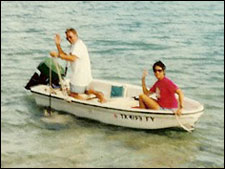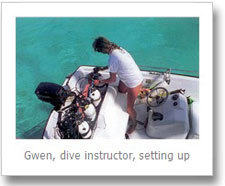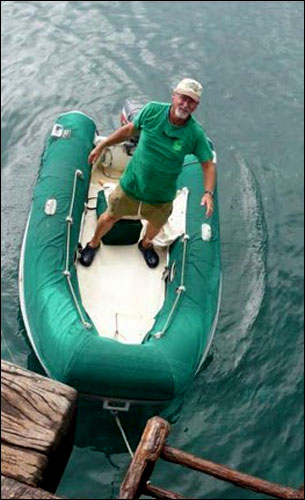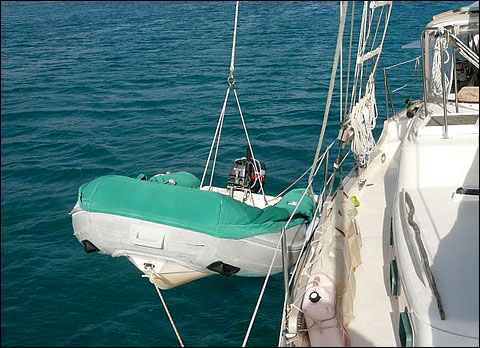Paul writes
I’m “right in the middle” on whether I want to take a RIB (Rigid Inflatable Boat) or hard dinghy to the Bahamas and Caribbean.What do you recommend? |
Kathy Parsons and Gwen Hamlin answer.
1) Kathy Parsons: I have used both. Next time I will get another RIB.
 I cruised with a hard dinghy for a number of years.
I cruised with a hard dinghy for a number of years.
We found a 12 foot Sears Gamefisher – it was actually plastic. It was getting a bit old and we ended up reinforcing it a bit with fiberglass especially in the transom.
It was a wonderful dinghy especially since those were years when we spearfished constantly.
It was a big dinghy, planed easily, didn’t pound in seas, and unlike many hard dinghies, it was easy to get into from the water. I could even stand on the gunnels without tipping it.
We didn’t have to worry that we would puncture it when we brought aboard fish and lobsters. And it rowed well!
 It did have its disadvantages though:
It did have its disadvantages though:
- It required very stout heavy-duty davits when we carried it on the stern.
- It could be a pain in areas with a lot of current – it could bang against the hull if we didn’t have it tied well with fenders.
- It was hard to put up on deck for passages and took lots of room. (I had a Whitby 42 at the time so it was manageable: it would have been too big for my current Downeast 38!). It took a 15hp outboard.
And once (long story) we swamped it with guests aboard at 2 in the morning! Eventually it wore out and we gave it to a Trini.
 We now have a RIB.
We now have a RIB.
It is a good dinghy for our Downeast 38. We have a 9.9hp outboard that is easier for us to get aboard. We can plane with it. It doesn’t look like much anymore after 12 years in the tropics but it still holds air well thanks to refurbishing by a good dinghy repairman (we have done this twice).
If we replaced it, we would get another RIB.
My friend Debbie single-hands and found her 12 foot inflatable and large outboard too much for her and her 29 foot Island Packet. She loves her little Walker Bay dinghy and small outboard. She can row it too. Plus she has the sailing rig for it.
Good luck with your decision. And happy cruising! Keep in touch!
All the best,
Kathy
2) Gwen Hamlin: Dinghy choice depends A LOT on what you think you want to do with it.
 For us, diving and snorkeling was a very large part of what we wanted to do while cruising, and the dinghy becomes a really important part of those activities, because it is safer and easier to position yourself on a desirable reef with a dinghy than with a big boat. And if there is any roll, managing scuba tanks on the big boat deck can be dicey. From the start of my charter biz through the end of my cruising career (which isn’t exactly over, just on hold), I set up my dive gear in the dinghy 98% of the time.
For us, diving and snorkeling was a very large part of what we wanted to do while cruising, and the dinghy becomes a really important part of those activities, because it is safer and easier to position yourself on a desirable reef with a dinghy than with a big boat. And if there is any roll, managing scuba tanks on the big boat deck can be dicey. From the start of my charter biz through the end of my cruising career (which isn’t exactly over, just on hold), I set up my dive gear in the dinghy 98% of the time.
My first dinghy in the charter business was an Achilles with an aluminum floor and a soft bottom and a 25hp Yamaha.This was a great dinghy.
It was light enough to pull onto the beach and the aluminum floor gave a us a solid surface for standing and working with dive gear and the pontoons were small enough that it was easy for my divers to get back into from the water. The smaller pontoons did make for a slightly wetter ride in choppy conditions.
As a charter boat in the BVI, I never lifted the dinghy out, but towed it behind. That meant the bottom got gross often and eventually I put bottom paint on it. But then, on the one occasion I did go cruising down island with it, I got bottom paint all over the boat deck. A mess. It would have been easy to lift the dinghy at night alongside the boat as we did in later years cruising which would have kept the bottom clean without the bottom paint and work! Live and learn.
My second dinghy was a really big 13′ Caribe that I bought from another charter boat. This dinghy was a big mistake.
Yes, it was bigger so I could accommodate up to four divers, and the ride was drier, BUT the big pontoons made it very hard to get out of the water, and even dinghy ladders didn’t really help.
It needed a huge 40hp engine which went very fast…maybe dangerously so! — and the engine which did not have automatic tilt was a struggle to tilt. It was very hard to see over the bow when motoring slowly, and the drag behind the boat was marked. This dinghy came with the name Jaws, and it was well named; it loomed over you!
It was handy after the awful hurricanes we had in St. Thomas in 1995 for hauling ground tackle and tugboat boats around, but then I had few options for securing it during storms. (We staked it out like a big boat, partially deflated the pontoons, and pulled the plug to let it fill with water so it couldn’t fly around…a very effective system for any dinghy you can’t get on deck.)
My next dinghy, still in the charter mentality, was a great deal I got after the bad hurricane season.
 This was a Boston Whaler v-hull all set up with a little dive platform (and bimini and railings which I got rid of). This dinghy also had a 40hp engine, but with power tilt and engine start battery! It was speedy in a comfortable way and I equipped it with tanks holders which made it a great dive tender. Still it was heavy to tow and, like the big Caribe, there was no option to get it out of the water onto my 44′, nor could I have hoisted either big dinghy alongside at night without producing a major list in the big boat!
This was a Boston Whaler v-hull all set up with a little dive platform (and bimini and railings which I got rid of). This dinghy also had a 40hp engine, but with power tilt and engine start battery! It was speedy in a comfortable way and I equipped it with tanks holders which made it a great dive tender. Still it was heavy to tow and, like the big Caribe, there was no option to get it out of the water onto my 44′, nor could I have hoisted either big dinghy alongside at night without producing a major list in the big boat!
 Our last dinghy was an AB 10.4 RIB with a 15hp outboard. We chose this for Don’s boat (same boat as mine was!) when we brought her into charter. The AB RIB was just big enough to accommodate three divers, agile enough to get them and their gear to the dive sites, the pontoons were reasonably large to keep riders dry, but reasonably small with good handles for getting in from the water, and, most importantly, it was small enough to fit in the space on the cabin top under our staysail.
Our last dinghy was an AB 10.4 RIB with a 15hp outboard. We chose this for Don’s boat (same boat as mine was!) when we brought her into charter. The AB RIB was just big enough to accommodate three divers, agile enough to get them and their gear to the dive sites, the pontoons were reasonably large to keep riders dry, but reasonably small with good handles for getting in from the water, and, most importantly, it was small enough to fit in the space on the cabin top under our staysail.
I liked the “deck” layout of the AB with the small locker forward and the rowing seat (which we used intermitently.) I liked having the oars always there stowed on the sides (No oars the in the Whaler! – I took to carrying kayak paddles in case.)
We made this choice because we were thinking ahead to some cruising and the Whaler could not go! The floor was great to work on with dive gear, but, of course, unlike the whaler the gear had to be laid down in the front part of the dinghy to get it up on a plane.
 The RIB was, however, still quite heavy. We could winch it up alongside the boat with the spinnaker halyard and mast winch on a nightly basis which worked very well, but we had to use the windlass and spinnaker halyard to lift it all the way onto the deck.
The RIB was, however, still quite heavy. We could winch it up alongside the boat with the spinnaker halyard and mast winch on a nightly basis which worked very well, but we had to use the windlass and spinnaker halyard to lift it all the way onto the deck.
Getting it up a beach was pretty near impossible until we discovered Happy Wheels, dinghy wheels, which are very popular with Pacific America cruisers where the tides are much greater than in the Caribbean BUT it was not something I could do single-handed!
I loved that AB and I loved the Achilles. Both were of Hypalon material which is the only inflatable material to have in the tropics. I know there are many new models of both these dinghies now, and I don’t know what I would choose. I couldn’t deal with a floor that wasn’t flat, like the very lightweight AB.
I don’t like the Caribe’s bigger pontoons, and I really would prefer a dinghy I could beach myself. (I singlehanded for a month and my solution was to anchor the dinghy off.)
I’m not sure I wouldn’t, for cruising, go back to a dinghy like the Achilles with a soft bottom and removable but rigid floor. You do have to take more care with soft bottoms when beaching them, than a RIB, but it a LOT lighter. Hoisting alongside would keep the bottom clean. Achilles tends to be expensive, but all the old ones around I see are holding up. AB has some similar models. Those are the two manufacturers I would first consider. And probably Avon, though I’ve never loved the Avons, myself, but they are good quality. Just, be very wary of off brands. I’ve seen some of them turn sticky in the tropical heat, and Zodiacs will eventually fally apart in the tropical UV.
I DO feel strongly about Yamaha.
The 15hp outboard we had the first 3-4 years of cruising was a Johnson, and it was a lemon from the get go. It was finally stolen (one night when we were too lazy to hoist it alongside!) in Huatulco, Mexico and we almost pitied the thief while we celebrated the opportunity to replace it with a Yamaha. (We did get the dinghy itself back.)
I never had a lick of trouble with either of the Yamahas I have owned. An old salt insisted that Johnsons would outlast a Yamaha, and my retort was “Why would you want them to!” It was not the first problematic Johnson I’d had to deal with, but it came with a package price on that AB.
I guess you get what you pay for. Plus, Yamahas are everywhere, and it is very easy to get service for them, although it is wise to pick a model that is sold world-wide, as opposed to some of the unique models sold to US customers. However, 15hp is a nice size for cruising if you will be trying to move people and dive gear with any alacrity. Bigger is better if more people than 2-3, however, and smaller is fine if not schlepping dive gear.
By the way, we also did a lot of spearfishing in our two years in Mexico, and one does need to be careful with spearguns around inflatables. We never had a pop, but were were always ready in case. So be sure, if you plan spearing to choose a dinghy with three air chambers. No sure how they all come these days. This is hindsight speaking.
Hope this is helpful.
Read also on this website
- Accessorizing the Cruising Dinghy by Gwen Hamlin (Admiral’s Angle Column #67)
- Choosing the Cruising Dinghy’s Outboard by Gwen Hamlin (Admiral’s Angle Column #66)
- Choosing the Cruising Dinghy by Gwen Hamlin (Admiral’s Angle Column #65)
- Any recommendations on outfitting a boat for scuba diving? Gwen Hamlin answers.
- Dinghy Driving 101 (Admiral’s Angle #68) by Gwen Hamlin:
Driving the dinghy is a real skill worth learning early to support confidence and avoid dependence
If you have a question about going cruising
that you want answered,
email it to: kathy@forcruisers.com
or join the next Women and Cruising webinar!


This is an excellent discussion of the pros and cons of various dinghies!
We loved our Avon RIB w/ a 15-hp Yamaha engine. I could hoist it single-handedly on our davits with a block-and-tackle system.
But it went with the boat sale and on our new boat we just inherited a soft-bottom inflatable with only a 2-hp engine. Now we remember the old days of getting wet and not being able to giddy-up and skim.
It’s like getting an old clunker car after being used to a luxury model!
Hi, we have been cruising for 11 years and have had 4 inflatables, 2 hard bottom and 2 soft. Our favorite is the Carribe a 9.5 foot hard bottom. It has large tubes so its not tippy, I have a problem flipping hard dingys so they were ruled out early on. A 15 hp engine is perfect with this boat. we have had dink for 10 years and are ready for a new one. One thing that I have seen is that if you buy a dingy in cold countries the glue has a problem in extreme heat. A cover for your boat will extend its life as well and keep your bum from burning on a hot day. Another must for us is dingy wheels, we are on our 2nd set, 1st made out of aluminum, they bent, the second made out of stainless. We found that the large tires work better as well in deep sand, and that the wheels help our backs alot. Well have fun with whatever you buy!